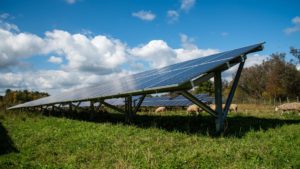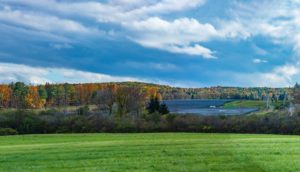Solar Grazing Project Combines Renewable Energy and Agriculture
Solar energy developers and farmers need land to operate, and a Cornell research project aims to demonstrate how co-locating solar arrays on farmland can be an environmentally friendly way to benefit both the renewable energy and agriculture industries.
In 2019 the Climate Leadership and Community Protection Act set a goal to reach 70% renewable energy in New York by 2030; to meet that goal, 21.6 GW of utility scale solar must be installed, potentially using up to 129,600 acres of land. A 2021 Cornell report projects that the New York sheep industry could grow significantly alongside the renewable energy industry if many sites are grazed.
Motivated by the push from New York state toward renewable energy, a transdisciplinary team at Cornell launched the Solar Grazing Project to investigate optimal sheep grazing management around ground-mounted solar arrays to avoid panel shading. Started in 2019 by postdoctoral research fellow Niko Kochendoerfer and Mike Thonney, late professor and director of graduate studies in Cornell CALS Department of Animal Science, the project taps experts in animal science, soil carbon sequestration, vegetation biodiversity and pollinator habitats to take a holistic view of the ecosystem.

Sheep grazing in Cascadilla Community Solar Farm.
Photo by Nicole Rossi
“Mike and I began hypothesizing sheep grazing and ideal management strategies,” said Kochendoerfer. “How many sheep per acre can a solar site pasture support? How many sheep do we need to successfully manage vegetation but also to provide ecosystem benefits like thriving pollinator habitat and optimized soil carbon sequestration?”
The 54-acre research site at the Cascadilla Community Solar Farm adjacent to campus is divided into five fenced arrays that serve as experimental blocks. Within each block, six different sheep grazing densities (mowed control, four, eight, 12, 16 and 20 sheep per acre) are tested to determine sheep management strategy for optimized animal welfare and production, plant biodiversity, pollinator habitat and soil carbon accrual.
Preliminary research results
Kochendoerfer tracks animal health data and flock productivity, as well as forage quantity and quality on site, to inform ideal vegetation management strategies from a sheep farmer’s perspective. Although the study is ongoing, Kochendoerfer has determined that sheep, if grazed at appropriate stocking densities, can effectively manage the vegetation in solar arrays, not allowing plants to grow to heights that would interfere with sunlight reception by the solar panels.
“Benefits for the sheep, such as quantities of high-quality forage, and optimally managed vegetation from a solar developer perspective are not mutually exclusive, profiting both industries,” said Kochendoerfer. “Sheep flocks also benefit from the shade provided by the panels in solar arrays, so animal welfare, flock health and productivity are high.”
Antonio DiTommaso, professor of weed science and chair of the Soil and Crop Sciences Section in the School of Integrative Plant Science evaluates how the resident vegetation on the solar array site might provide ecosystem services through the increased presence of pollinators and other beneficial insects. DiTommaso will also determine how the resident vegetation is impacted by the density and frequency of sheep grazing and whether plant species diversity is affected.
“So far, I am encouraged by the number and diversity of plant species present on the site despite two years of sheep grazing,” said DiTommaso. “Interestingly, several locally adapted plant species that were not present at the start of the project are now found on the site.”
Entomologist Scott McArt, assistant professor of pollinator health, is interested in understanding whether sheep grazing can benefit pollinator communities by providing more floral resources. According to McArt, the results of the study are promising and suggest that intermediate levels of grazing could, indeed, increase numbers of flowers and bees.
“If grazing sheep on solar sites can increase foraging resources for bees, the increase of solar sites in New York is a huge opportunity to simultaneously promote agriculture (sheep), conservation (pollinator habitat) and renewable energy (solar),”
McArt said. “With targeted research on this topic, I’m hopeful we can make data-driven recommendations to bear out this tantalizing win-win-win scenario.”

Cascadilla Community Solar Farm.
Photo by Steven Wang
Soil organic carbon levels are one of the project’s variables and are best examined in the long term, according to Johannes Lehmann, the Liberty Hyde Bailey Professor in the School of Integrative Plant Science Soil and Crop Sciences Section. Therefore, Lehmann and his team are focusing on mechanistic research, studying the underlying changes and trends in soil carbon, rather than just the results.
“In order to examine the relationship between animal husbandry and soil organic carbon, this experiment would need to go on for almost 10 years,” Lehmann said.
“Interdisciplinary projects like this one demand an institutional commitment to pursuing long-term results and expanding the reach of the project.”
Raising awareness
The researchers believe the Solar Grazing Project will have implications for farmers and solar developers nationwide. If clear environmental and ecosystem benefits can be demonstrated, developers could decide to use sheep to control vegetation at their solar projects, and farmers could see increased revenue by managing vegetation in solar arrays while meeting sustainability goals. The research team has begun publishing preliminary results from this trial and are eager to compare results year after year.
Communicating the outreach findings is a key component of the project. The research team works closely with the Cornell Cooperative Extension Community and Energy Work Team, whose mission is to provide education about energy consumption, conservation, production and distribution in the state. Workshops and presentations at extension events help communicate with farmers and support them in adapting to a changing market. Collaborations with such industry associations as the American Solar Grazing Association will allow for nationwide dissemination of findings.
Funding for the Solar Grazing Project began in 2019, with a two-year Academic Venture Fund grant from the Cornell Atkinson Center for Sustainability and an Engaged Cornell Academic Venture Fund Supplemental Grant. A short, proof-of-concept grazing trial in 2019 was followed by the first full grazing season in 2020. Niko Kochendoerfer and Mike Thonney grew the project to include five labs across the Department of Animal Science, the School of Integrative Plant Science, the Department of Entomology and universities beyond Cornell; and several undergraduate and graduate students and interns participate in the transdisciplinary research work. In 2021, Kochendoerfer received a USDA Postdoctoral Fellowship to continue data collection for three seasons.

